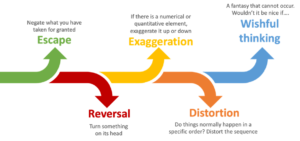Tapping into your creative potential one step at time by Caryn Douglas
How often have we heard someone say, “Oh, I’m not creative”, or even said it ourselves. There is a pervasive belief that creativity is a talent that some people are born with and others are not. Education systems don’t help here, offering few opportunities to practice creative thinking or even treating creativity as a developable skill in its own right.
Edward de Bono disagreed with the notion of creativity being something people were either good at or not. He was a vocal proponent of simple structured processes for creativity, approaching it as a key business skill rather than as a mystical talent.
Innovation is at the heart of the h2h business. We work hard to ensure that what we deliver for our customers is relevant and stimulating, continuously improving materials and methods. At our recent learning day, we challenged our consultants to move beyond continuous improvement and think about new and fresh approaches or radical changes to the way they deliver training interventions.
We used de Bono’s provocation and movement technique, focusing on a specific intervention we deliver. Small groups chose one of the provocations to see how they could change their view of the way they deliver that work.

With their new perspective, the groups then applied one of the movement techniques. These take the provocation and suggest ways to draw out new conceptual thinking from that expanded view. This could be extracting an underlying concept, comparing old and new realities, thinking through the new reality in a moment-to-moment fashion, looking for specific benefits of the new reality and if they could be achieved more practically, or even if there are specific circumstances where even a whacky idea can be implemented immediately.
New ideas ranged from building reward into making introductions on workshops, using AI to frame questions, ditching PowerPoint entirely, live co-creation of learning interventions with participants with evaluation at the start, and creating video evaluations.
Some of these ideas were entirely new, while some were familiar to a few in the room but not all, yet again underlining the value of working with others on creative tasks. All participants agreed that having a process to follow really helped get over the fear of not being able to come up with new ideas.
Feedback afterwards was also positive, with comments including:
“Loved the session on innovation and has for me really thinking how we can challenge, redevelop, innovate around what we might consider our more established traditional ways of training and developing!!”
“A key takeaway for me was applying lateral thinking to in order to innovate.”
De Bono has a lot more to say on creativity and innovation. He coined the phrase, ‘lateral thinking’, and quite literally wrote the book. He makes one important distinction between different types of lateral thinking. Divergent thinking – where we think ‘outwards’ from a starting point – can take us only so far. He uses the metaphor of digging a hole and then digging deeper or tunnelling outwards. But he says that to be truly creative, we need to dig a different hole. Structured lateral thinking processes can help us make that initial ‘leap’ to a new digging place and help us make sense of what we find there to apply in the real world.
Interested in reading more?
Read: Lateral Thinking by Edward de Bono
Serious Creativity: Using The Power Of Lateral Thinking To Create New Ideas by Edward de Bono
How to Have Creative Ideas: 62 Games to Develop the Mind by Edward de Bono